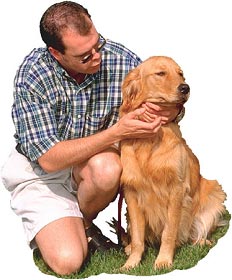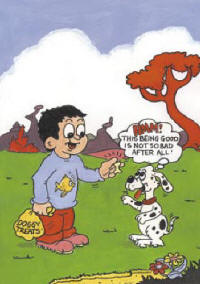|
Desensitization,
Counter Conditioning,
Differential
Reinforcement, and Flooding
Counter-conditioning
and Desensitization
Counter-conditioning
and desensitization are powerful
ways to change behavior. They
are usually used in combination.
Desensitization provides a means
of safely exposing the pet to
the stimulus at a level at or
below which fear is likely to
be exhibited. Counter-conditioning
is used to change the pet's
attitude or emotional response
to a stimulus. Differential
reinforcement or response substitutions
are techniques that can be used
to change a pet's response
from one that is undesirable
to one that is desirable through
the proper use and timing of
reinforcement. Although counter-conditioning
may also be used to describe
the practice of teaching an
alternative and appropriate
response to the stimulus, for
clarity we will use the terms
differential reinforcement or
response substitution throughout
these handouts.
What
is counter-conditioning?
Counter-conditioning
is changing the pet's
emotional response, feelings
or attitude toward a stimulus.
For example, the dog that lunges
at the window when the mailman
walks by is displaying an emotional
response of fear or anxiety.
Counter-conditioning would be
accomplished by pairing the
sight, sounds and approach of
the mailman with one of the
dog's favored rewards
to change the emotional state
to one that is calm and positive.
What
is desensitization?
Desensitization
is the gradual exposure to situations
or stimuli that would bring
on the undesirable behavior,
but at a level so low that there
is no negative response. As
the animal experiences the stimulus,
but does not respond in the
undesirable way, the animal
becomes "less reactive"
to the stimulus, and the pet
can soon tolerate a somewhat
more intense stimulus without
exhibiting the undesirable response.
The key to effective desensitization
is to design a stimulus gradient
so that the pet can be gradually
exposed to progressively more
intense levels of the stimulus
without the undesirable behavior
being elicited.
What
is differential reinforcement?
Reinforcement
of a response that is incompatible
with the undesirable response
is referred to as differential
reinforcement of an incompatible
response (DRI)) while reinforcement
of any alternative response
is known as DRA. There are a
number of techniques that can
be used to help the owner turn
the inappropriate response into
one that is desirable. If the
dog is trained through reward
based techniques to immediately
focus on the owners in response
to commands (settle, watch),
the command might then be used
to achieve the appropriate response
(sometimes referred to as counter-commanding).
Alternatively disruptive devices,
head halters, and lures can
be used to get the alternative
or incompatible response that
can then be reinforced. For
many dogs, the head halter and
leash is often the safest, most
effective and most immediate
method to obtain the desired
response (e.g. sit, focus, heel),
which is then reinforced by
release (negative reinforcement)
and positive reinforcement (the
pet's favored reward).
Regardless of the technique
used, if the pet can be taught
to display a new acceptable
response instead of the undesirable
response when exposed to a stimulus
then response substitution has
been achieved. Again, rather
than attempting to overcome
an intense response, the training
should be set up to expose the
dog with stimuli of reduced
intensity to ensure a successful
outcome.
The
task is not complete until the
dog's fearful reaction
to the stimulus is replaced
by a response to the stimulus
that is relaxed and positive
(counter-conditioning).
How
might these techniques be used
in a training situation?
Take
the example of the mailman.
 Begin by getting the dog to
sit quietly by the window. Use
food as an inducement to the
dog to respond, and as a reward
for performance. When the dog
anticipates a food reward, the
"mood" of the dog
is usually happy, relaxed and
not anxious or aggressive. These
are behaviors that are incompatible
with the behavior you wish to
change, in this case lunging
at the window at the mailman.
This is counter-conditioning.
It may take days or weeks for
the dog to learn how to perform
this task reliably on command.
During that time phase out food
rewards so that the dog does
the task equally well with or
without food. Begin by getting the dog to
sit quietly by the window. Use
food as an inducement to the
dog to respond, and as a reward
for performance. When the dog
anticipates a food reward, the
"mood" of the dog
is usually happy, relaxed and
not anxious or aggressive. These
are behaviors that are incompatible
with the behavior you wish to
change, in this case lunging
at the window at the mailman.
This is counter-conditioning.
It may take days or weeks for
the dog to learn how to perform
this task reliably on command.
During that time phase out food
rewards so that the dog does
the task equally well with or
without food.
Next,
train the pet to perform the
desired behavior in the presence
of the mailman. Desensitize
the dog, by presenting the stimulus,
the mailman, at a low enough
level so that the dog will still
remain sitting and be relaxed,
happy and not anxious or aggressive.
Start by having someone the
dog knows, WHO IS NOT THE MAILMAN,
walk by the window. The dog
gets to practice the good behavior
when it is easy. Repeat this
many times so that the dog does
it reliably. Gradually progress
to stimuli that more closely
resemble the real life situation.
Perhaps have the dog sit by
the window when the mailman
is down the street. If the dog
could do this well several times,
try when the mailman is across
the street. It may be necessary
to take the dog outside. Proceed
slowly, so that the dog learns
how to perform the desired behavior
over and over before being challenged
with the real thing, the mailman
delivering the mail to his door.
What
are other ways to design a stimulus
gradient for desensitization?
In
the example of the mailman the
stimulus gradient was to begin
the training with a family member
and then progress with the mailman
at varying distances. Stimuli
for desensitization can be arranged
from mildest to strongest in
a number of ways. For example,
begin desensitization from a
distance and move progressively
closer as the pet is successfully
counter-conditioned. Sound stimuli
can be presented in varying
intensities from quiet to loud.
A pet that is fearful or aggressive
toward a man with a beard might
be desensitized to young boys,
older boys, men with no beards,
a family member with a costume
beard, familiar men with beards
and finally strangers with beards.
Distance can also be varied.
Dogs that are aggressive or
fearful as strangers arrive
at the front door, could be
desensitized and counter-conditioned
to the doorbell being rung by
a family member, a family member
arriving in a car, a family
member walking up the front
walkway, a stranger walking
along the path in front of the
home (while the dog remains
in the doorway or on the porch),
a familiar person entering the
home, and finally a stranger
at the front door.
In
order for desensitization and
counter-conditioning programs
to be successful, it is necessary
to have good control of the
pet, a strongly motivating reward,
good control of the stimulus,
and a well-constructed desensitization
gradient. A leash and head halter
is often the best way of ensuring
control over the dog. Each session
should be carefully planned.
Pets that are punished for inappropriate
behavior (fear, aggressive displays)
during the retraining program
will become more anxious in
association with the stimulus.
Owner fears, anxiety or frustration
will only serve to increase
the pet's anxiety.
Pets
that are rewarded during the
retraining program will get
worse. Whenever a pet can successfully
threaten and the stimulus (person,
other animal) retreats, the
behavior is further reinforced.
How
might differential reinforcement
be used?
For
counter-conditioning to be successful
each exposure must have a relaxing
or positive result. This means
that ideally exposure to the
stimulus must be prevented unless
a desirable outcome can be insured.
Desensitization so that exposure
is always below the threshold
for fear allows for proper counter-conditioning.
However when the exposure is
slightly above the threshold
for fear the options are to
a) keep the pet in the situation
until it habituates and then
counter-condition with favored
food rewards b) use any available
method (that does not cause
fear) to interrupt the undesirable
response and achieve the desirable
response (command, lure, disruptive
device, head halter) so that
an alternative acceptable behavior
can be reinforced. If at the
end of the session the pet is
calm and relaxed and has received
favored rewards in the presence
of the stimulus, then counter-conditioning
may have also been achieved.
How
might flooding and exposure
techniques be used?
Another technique for reducing
fearful behavior is to continuously
expose the pet to the stimulus
until it settles down (habituates).
This technique will only work
if the stimulus is not associated
with any adverse consequence,
and the pet is exposed for as
long as is needed until the
pet calms down. Once the pet
is exposed, the stimulus must
not leave or be removed until
the pet calms down. Similarly
the pet must not be removed
or allowed to retreat until
the pet habituates. Once the
pet settles, reinforcement can
be given to ensure that the
ultimate result is a positive
association with the stimulus.
The pet must not be rewarded
until it calms and settles down
as this would serve to reward
the fearful behavior. Owner
intervention or punishment must
not be utilized as this would
lead to an unpleasant association
with the stimulus. Since exposure
must continue until the pet
settles down, flooding is most
successful for fears that are
not too intense. Beginning with
a somewhat lower or muted stimulus
may be best. In practice, keeping
the pet in a cage or kennel
or keeping a dog on a leash
and halter during exposure to
the stimulus, will prevent escape
and prevent injury to the stimulus
(person or pet).
This client
information sheet is based on
material written by Debra Horwitz,
DVM, DACVB and
Gary Landsberg, DVM, DACVB.
© Copyright 2002 Lifelearn
Inc. Used with permission under
license. March 11, 2004. |